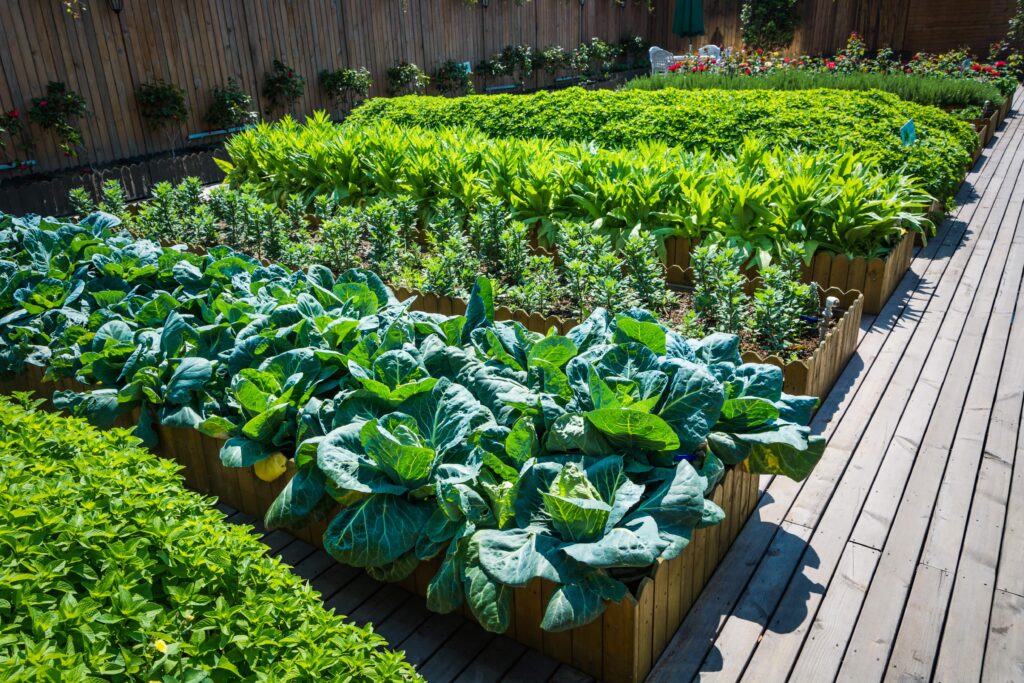Kitchen gardening, also known as edible gardening, is the perfect way to teach ESD. It is a trend gaining popularity in schools around the world. And a bandwagon Pakistani schools should quickly jump on!
Education for Sustainable Development (ESD) has fast taken storm in the global ‘atmosphere’. Yet, schools are unprepared to meet the challenges of teaching these skills in the traditional education system.
ESD is embedded in curricula even when it is not obvious. Its streams across subjects, all you have to do is bring it to the fore. It inculcates project based learning, future skills, transferable skills and so much more!
Discover where kitchen gardening becomes a powerful catalyst for cultivating a generation that not only learns but also lives the principles of sustainability. In this blog, we will explore why kitchen gardening in schools is important for us, our health, and the environment.
What is the Importance of Kitchen Gardening for Students?
Kitchen gardening is one often overlooked thread that holds immense potential. For cultivating knowledge, responsibility, self awareness and a greener tomorrow. We are always learning about how to make our world a better place. A great way to do that is by having gardens right on our premises!
Yes, you read that right – kitchen gardening in schools is not just about growing plants. It’s about:
- Healing oneself
- Healing others
- Teaching gratitude
- Teaching patience
- Understanding effort
This in turn transfers to:
- Developing leadership skills
- Becoming an agent of change
- Critical thinking
Beyond textbooks and traditional classrooms, the fertile grounds of a school garden provide a living laboratory. Where students can dig into the roots of sustainability.
This hands-on approach not only nurtures a deeper understanding of environmental concepts but also fosters essential life skills. Connecting students with the very source of their sustenance
This isn’t your typical classroom stuff. It’s an adventure where we discover how ecosystems and nature function.
Yet that isn’t all. Kitchen gardening has statistically proven growth in student improvement.
Key Advantages of Kitchen Gardening
1. Increased Academic Achievement
Kitchen gardening offers us a unique opportunity to learn through hands-on experiences. According to various studies, students who participate in school gardening activities score higher on science achievement tests compared to those who do not.
Why? By actively planting seeds, nurturing plants, and observing their growth, students learn about plant life cycles, the role of sunlight and water, and the importance of soil health. This practical and more positive experience will create a memory forever. Because, lets face it, sitting in a prison like classroom, with the textbook in front of you, creates no love for learning. No connection to the topic, and no core memory.
Gardening can improve critical thinking skills and promote problem-solving abilities. When we encounter challenges like pests or plant diseases, we learn to find solutions, think creatively, and adapt our gardening practices. In short, you enhance learning. This critical thinking ability provides better opportunities to think critically in other spheres of life. In essence, increasing student academic achievement.

2. Better Habits
Gardening promotes healthy eating habits and improves our nutrition. By growing our own fruits and vegetables, we make healthier food choices. We reduce our reliance on processed snacks and sugary beverages.
Studies have found that students who engage in school gardening consume more fruits and vegetables. They seem to develop a higher preference for these foods. Growing one’s own food gives us a sense of ownership and achievement. It encourages us to try new and nutritious foods that we may not have considered before.
It also requires taking a break from screens and spending time outside. This in itself is a better habit. Lesser screen time means lesser time spent on social media, lesser drain on mental health.
Physical activity such as digging, bending, lifting, pruning, harvesting are also beneficial. Bettering student motor skills and increasing their daily mobility. Forget the treadmill, take your students gardening!
3. Environmental Awareness
Kitchen gardening teaches us to care for the environment and make sustainable choices. Agriculture contributes to approximately 14% of global greenhouse gas emissions.
By practicing sustainable gardening methods like composting, organic pest control, and water conservation, students can visibly see how to reduce our impact on the environment.
Additionally, more plants and flowers promotes biodiversity and supports ecosystems. School gardens provide habitats for beneficial insects and birds. Creating a balance in nature. Gardens help conserve biodiversity by providing shelter and food for different organisms.
The world and traditional education system teaches us that everything works in silos. A kitchen garden teaches you that no one aspect can function without the other.
4. Food Literacy and Food Security
Kitchen gardening enhances our understanding of where our food comes from and promotes food security. 690 million people worldwide suffer from hunger, while 3 billion people cannot afford a healthy diet. By growing our food, we become more self-reliant and contribute to our food security.
Additionally, school gardens can support local food systems and supply fresh produce to school cafeterias. Reducing the reliance on processed and less nutritious foods. Excess produce can also be shared with the community, helping to address food insecurity.
With plenty of organic ingredients, this creates an opportunity to create one’s own food. Students can take to the kitchen and learn how to cook, manage and organize this essential part of the home. A crucial life skill for all students (no gender discrimination here!).
Who knows, you set out some sustainably inclined chefs into the world too.
5. Emotional and Mental Well-being
Kitchen gardening has a positive impact on our emotional and mental well-being. Gardening activities have been shown to reduce stress and improve mood. Working with plants and being in nature provides a sense of peace and relaxation. Helping us unwind from the pressures of school life.
Furthermore, kitchen gardening promotes social interaction and teamwork. When we work together in the garden, we learn to:
- Communicate and collaborate effectively
- share responsibilities, and:
- Develop positive relationships with our peers.
This sense of community and collaboration contributes to our overall well-being. We learn both, how to be reliant on ourselves, and how to be reliant on others. Creating a balance.
Perhaps most importantly, it builds empathy. Loving a plant, and ones garden, with all its creepy, crawlies. Investing every little bit of yourself into you space, creates a deeper sense of love and care.

How to Learn Kitchen Gardening?
How do you manage a kitchen garden? It’s very simple really. You first establish your garden, and the garden maintains itself for the most part! Take baby steps. Learning kitchen gardening is a fun and hands-on experience that is easy for anyone. Even if you’re a first timer!
Start by Choosing a Sunny spot
This is how you teach photosynthesis. Without sunlight, plants don’t have food or energy. Rooftops are a great place for continuous sunlight. Though you need to ensure safety. Create a vertical garden on a wall that gets a lot of sun! In the heat of the summer, this will also effectively cool that wall and room.
Why not plant some pots in the shade and some in the sunlight. Ask students to make observations of their growth rates. Merge it with math! Take it up a notch and plant some shade friendly plants. Ask students to observe how they are growing. What makes them so able to grow in the shade? Bring in science.
Pick Easy-to-Grow Veggies
Set yourself up for success! Vegetables like tomatoes or herbs like basil grow easily. You want your students’ experience to be a positive one. All you need is some good soil, a few pots or containers, and plant your chosen seeds or seedlings. Now all you have to ensure is
As they grow, observe how they change. Take this opportunity to make ‘field notes’ with your students. Ask them to make observations as if they are scientists! Ask parents to join in on the fun. This will build relationships, a sense of community and healing for all.
Keep it Organic
Making use of organic pesticides and fertilizers is the best way to ensure both plant and your health. Did you know for every one pest there are about 1500 beneficial plants or species to counter it. You can simply do some research and find which plants work well together. Plant them near each other and benefit each other. This is called symbiosis! (another way to integrate it with a science lesson).
Otherwise you can always resort to homemade insecticides. Why? We are teaching our students to be free of all chemicals that would enter our body and also poison the environment.
Composting is one other way to keep things organic. Encourage composting in your school. You can keep a composting bin, or create a composting ditch. (No it does not smell). Keep a poster that teaches your students what is compostable.
This will teach them about sustainable living that does not contribute to pollution and thus climate change. Creating another opportunity to discuss the human impact on the environment – great for social studies.

Final Word
That’s it! It’s not so hard to grow your food. The challenge is how to integrate it into your everyday school activities.
Kitchen gardening in schools is a fantastic way for us to learn, improve our health, and contribute to a greener world. By getting our hands dirty, we can gain valuable knowledge about plants, make healthier food choices, understand the importance of sustainability, support local food systems, and enhance our well-being. Let’s embrace kitchen gardening and cultivate our green thumbs for a brighter and healthier future!
Don't know How to Start Kitchen Gardening in Your School?
Want a quick guide on how to establish and maintain your kitchen garden? Download our FREE kitchen gardening guide for schools
Download now

